What'sNEW Archives, July-October 2004

30 Oct 2004
Horizontal transfer isn't something that occurred once or twice in the earliest history of life; it is a continuing and persistent means of creating biological novelty.
 Andrew Knoll, Life on a Young Planet: The First Three Billion Years of Evolution on Earth, ISBN: 0-691-12029-3, Princeton University Press, 2003. p 29. Andrew Knoll, Life on a Young Planet: The First Three Billion Years of Evolution on Earth, ISBN: 0-691-12029-3, Princeton University Press, 2003. p 29.
 Viruses... is a related CA webpage about evolution by gene transfer. [Next-What'sNEW about HGT-Prev] Viruses... is a related CA webpage about evolution by gene transfer. [Next-What'sNEW about HGT-Prev]
29 Oct 2004
Abundant evidence for various gene transfer mechanisms supports our hypothesis that useful new genetic programs must come via gene transfer. If so, how would the new genetic programs get installed and activated? We have suggested that eukaryotes might employ familiar DNA repair and recombination systems for this purpose. Now, additional mechanisms that could participate in the process are illuminated by new research on rice genomes —
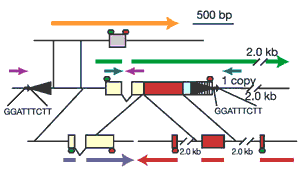 Pack-MULE transposable elements mediate gene evolution in plants. Geneticists from the University of Georgia and Washington University think so after examining Mutator–Like transposable Elements (MULEs) that are found in many eukaryotic genomes. In well-studied plants they are known to carry fragments of cellular genes. The researchers named these ones "Pack-MULEs".
Pack-MULE transposable elements mediate gene evolution in plants. Geneticists from the University of Georgia and Washington University think so after examining Mutator–Like transposable Elements (MULEs) that are found in many eukaryotic genomes. In well-studied plants they are known to carry fragments of cellular genes. The researchers named these ones "Pack-MULEs".
Their report in Nature states, "Functional analysis of amino acid sequences and proteomic data indicate that some captured gene fragments might be functional. Comparison of the cellular genes and Pack-MULE counterparts indicates that fragments of genomic DNA have been captured, rearranged and amplified over millions of years. Given the abundance of Pack-MULEs in rice and the widespread occurrence of MULEs in all characterized plant genomes, gene fragment acquisition by Pack-MULEs might represent an important new mechanism for the evolution of genes in higher plants." Later they report, "...Sequence acquisition must have occurred over a long time frame, perhaps millions of years, and might still be occurring." A sample indicates that 5% of the captured sequences are transcribed. The article concludes, "...About one-fifth of the identified Pack-MULEs contain fragments acquired from multiple genomic loci, thus demonstrating their potential to create novel genes through the duplication, rearrangement and fusion of diverse genomic sequences."
 Ning Jiang, Zhirong Bao, Xiaoyu Zhang, Sean R. Eddy and Susan R. Wessler, "Pack-MULE transposable elements mediate gene evolution in plants" [abstract], p 569-573 v 431, Nature, 30 Sep 2004. Ning Jiang, Zhirong Bao, Xiaoyu Zhang, Sean R. Eddy and Susan R. Wessler, "Pack-MULE transposable elements mediate gene evolution in plants" [abstract], p 569-573 v 431, Nature, 30 Sep 2004.
 Viruses... is a related CA webpage about evolution by gene transfer. [Next-What'sNEW about HGT-Prev] Viruses... is a related CA webpage about evolution by gene transfer. [Next-What'sNEW about HGT-Prev]
 Robust Software Management in Genomes: this page, begun 2017, is incomplete and under construction. Robust Software Management in Genomes: this page, begun 2017, is incomplete and under construction.
28 Oct 2004
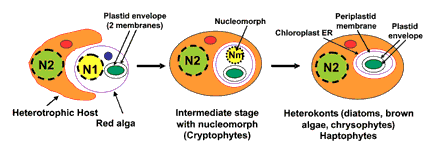 A diatom genome has been sequenced. A team of 45 genetictsts identified almost 11,500 genes in 24 nuclear chromosomes, a plastid and the mitochondria. "The assemblage of genes identified... reflects large-scale transfers of genes between genomes during establishment of the endosymbiosis," they write. Although many unexpected or unfamiliar genes are seeen, the only source they suggest for any genes not vertically inherited with retained function is transfer, usually following symbiosis.
A diatom genome has been sequenced. A team of 45 genetictsts identified almost 11,500 genes in 24 nuclear chromosomes, a plastid and the mitochondria. "The assemblage of genes identified... reflects large-scale transfers of genes between genomes during establishment of the endosymbiosis," they write. Although many unexpected or unfamiliar genes are seeen, the only source they suggest for any genes not vertically inherited with retained function is transfer, usually following symbiosis. In addition to genes from engulfed algae, diatoms also contain a mix of plant and animal DNA, for which horizontal transfer, by various means, provides the most economical account, we think. Evidence that any diatom gene was composed by standard duplcation and divergence is not mentioned. If we ask how species obtain new genetic programs, this research supports our hypothesis that are acquired from elsewhere, and not the theory that they are composed de novo.
 E. Virginia Armbrust et al., "The Genome of the Diatom Thalassiosira Pseudonana: Ecology, Evolution, and Metabolism" [abstract], p 79-86 v 306, Science, 1 Oct 2004. E. Virginia Armbrust et al., "The Genome of the Diatom Thalassiosira Pseudonana: Ecology, Evolution, and Metabolism" [abstract], p 79-86 v 306, Science, 1 Oct 2004.
 Elizabeth Pennisi, "DNA Reveals Diatom's Complexity" [summary], p 31 v 306, Science, 1 Oct 2004. Elizabeth Pennisi, "DNA Reveals Diatom's Complexity" [summary], p 31 v 306, Science, 1 Oct 2004.
 Viruses... is a related CA webpage about evolution by gene transfer. [Next-What'sNEW about HGT-Prev] Viruses... is a related CA webpage about evolution by gene transfer. [Next-What'sNEW about HGT-Prev]
28 Oct 2004
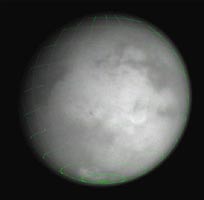 Cassini flew by Titan, 1200 km above its surface at 8:30 AM Pacific time, 26 October. The atmosphere was less cloudy and more diverse than NASA expected, and the light and dark splotches on the surface remain unexplained. This was the first of planned series of 45 close flybys of Saturn's largest moon. Eventually Cassini will release a probe named Huygens to descend to Titan's surface and investigate, among other things, the source for methane there.
Cassini flew by Titan, 1200 km above its surface at 8:30 AM Pacific time, 26 October. The atmosphere was less cloudy and more diverse than NASA expected, and the light and dark splotches on the surface remain unexplained. This was the first of planned series of 45 close flybys of Saturn's largest moon. Eventually Cassini will release a probe named Huygens to descend to Titan's surface and investigate, among other things, the source for methane there. Larger than Mercury or Pluto, Titan has an appreciable atmosphere — that's unique among moons in the solar system. Furthermore, the air's composition (mostly nitrogen) and surface pressure (1.6 Earth atmospheres) are comparable to Earth's. But at 95° K, the air on the surface is much colder.
 Cassini-Huygens Mission to Saturn, NASA. Cassini-Huygens Mission to Saturn, NASA.
 Cassini-Huygens Titan-A Flyby, NASA, JPL, CalTech, 26 Oct 2004. Cassini-Huygens Titan-A Flyby, NASA, JPL, CalTech, 26 Oct 2004.
 PDF: Titan-A Mission Description, NASA, JPL, CalTech, Oct 2004. PDF: Titan-A Mission Description, NASA, JPL, CalTech, Oct 2004.
 Probe data reveal Titan's etched face, by Helen Pearson, Newsw@Nature.com, 29 Oct 2004. Probe data reveal Titan's etched face, by Helen Pearson, Newsw@Nature.com, 29 Oct 2004.
 John Noble Wilford, "Radar Images Suggest a Saturn Moon's Landscape Contains Basins of Ice" [text], The New York Times, 28 Oct 2004. John Noble Wilford, "Radar Images Suggest a Saturn Moon's Landscape Contains Basins of Ice" [text], The New York Times, 28 Oct 2004.
 Life on Europa or Other Moons? has links to other items about Cassini and Huygens. Life on Europa or Other Moons? has links to other items about Cassini and Huygens.
 Gaia is a related CA webpage about atmospheric compostion. Gaia is a related CA webpage about atmospheric compostion.
26 Oct 2004
 Liquid water on comets? NASA scientists Rob Sheldon will present evidence therefor at NASA's National Space Science and Technology Center in Huntsvlle, Alabama, Friday, 29 October.
Liquid water on comets? NASA scientists Rob Sheldon will present evidence therefor at NASA's National Space Science and Technology Center in Huntsvlle, Alabama, Friday, 29 October.
 Rob Sheldon's email is posted as a "Reply," 25 Oct 2004. Rob Sheldon's email is posted as a "Reply," 25 Oct 2004.
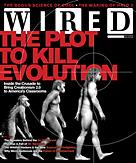
26 Oct 2004 A discussion of the Intelligent Design movement is published in Wired Magazine and posted online, with a disapproving overview and a briefer, pro ID statement. We wish we could get invited to the debate!
 The Crusade Against Evolution, by Evan Ratliff, and "Biocosm" [on the same page] by George Gilder, Wired Magazine, Oct 2004. The Crusade Against Evolution, by Evan Ratliff, and "Biocosm" [on the same page] by George Gilder, Wired Magazine, Oct 2004.
 Evolution vs Creationism is a related CA webpage. Evolution vs Creationism is a related CA webpage.
 Thanks, John Slorp. Thanks, John Slorp.
22 Oct 2004
Fungi from deep sea sediments revive, according to Indian scientists. Extracted from cores taken in the Indian Ocean's Chagos Trench, fungi deposited there from 180,000 to 430,000 years ago were successfully cultured. "The finding adds to growing evidence for the impressive survival capabilities of many microorganisms," says BBC News.

 Ancient fungus 'revived' in lab, BBCNews, 19 Oct 2004. Ancient fungus 'revived' in lab, BBCNews, 19 Oct 2004.
 Bacteria... is a related CA webpage with lots about the survival capabilities of prokaryotes. Bacteria... is a related CA webpage with lots about the survival capabilities of prokaryotes.
 Thanks, Larry Klaes. Thanks, Larry Klaes.
21 Oct 2004
Eukaryote-to-eukaryote lateral gene transfer is the best explanation for the unusual distribution of an apparently essential gene. Biologists Patrick J. Keeling and Yuji Inagaki reached this conclusion after observing that a gene termed EFL (Elongation Factor-Like) is "scattered accross the tree of eukaryotes," while the closest relatives of the EFL-endowed eukaryotes usually carry a related, bettter-studied gene instead. The latter gene, designated eEF-1α, is "is a highly conserved core component of the translation machinery that is shared by all cellular life." Where it is absent, EFL must be providing its function. "Altogether, it appears that EFL has replaced eEF-1α several times independently. This finding could be an indication of an ancient paralogy or, more likely, eukaryote-to-eukaryote lateral gene transfer," say Keeling and Inagaki. In closing they comment, "Eukaryote-to-eukaryote transfers are beginning to be recognized to occur at some frequency..., and this interpretation of EFL distribution suggests such transfers may be more frequent than we presently think." On this website we suggest that organisms acquire new genetic programs by gene transfer. This genetic study offers additional evidence that gene transfer, even among eukaryotes, is a robust process. The mainstream darwinian theory holds that new genetic programs are gradually composed under the pressure of natural selection. We have seen little evidence for that process. (We welcome any submissions or pointers thereto.)

 Patrick J. Keeling and Yuji Inagaki, "A class of eukaryotic GTPase with a punctate distribution suggesting multiple functional replacements of translation elongation factor 1α" [abstract], 10.1073/pnas.0404505101, Proc. Natl. Acad. Sci. USA, online 18 Oct 2004. Patrick J. Keeling and Yuji Inagaki, "A class of eukaryotic GTPase with a punctate distribution suggesting multiple functional replacements of translation elongation factor 1α" [abstract], 10.1073/pnas.0404505101, Proc. Natl. Acad. Sci. USA, online 18 Oct 2004.
 Viruses..., a CA webpage, gives many other examples of lateral gene transfer. [Next-What'sNEW about HGT-Prev] Viruses..., a CA webpage, gives many other examples of lateral gene transfer. [Next-What'sNEW about HGT-Prev]
 Ken Jopp wonders what gene transfer has to do with CA, and Klyce replies, 21 Oct 2004. Ken Jopp wonders what gene transfer has to do with CA, and Klyce replies, 21 Oct 2004.
 New genetic programs in Darwinism and strong panspermia briefly explains why gene transfer corroborates CA. New genetic programs in Darwinism and strong panspermia briefly explains why gene transfer corroborates CA.
9 Oct 2004
Retroelements that confer a selective advantage have been identified in a bacterial virus. A team from California and Canada conclude that the sole purpose of the Reverse Transcriptase gene of the BPP-1 virus that infects Bordetella bacteria is to generate diversity in the virus's surface binding protein. This variability keeps the virus a step ahead of the bacteria's defense mechanism. The diversity-generating "cassette" makes random substitutions at positions designated by only one of the four nucleotides — A, but not G,C or T — on the "donor" template. The resulting 23 variable positions in the "recipient" sequence allow for some 10^12 possible binding proteins. This would be an especially well-documented example of "directed mutation."
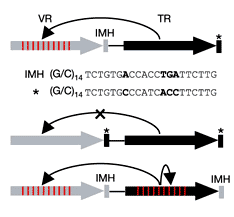 Retroelements such as retrotransposons were once thought to be examples of "selfish genes," but this gene is clearly beneficial to the viral species carrying it. Interestingly, genes with similar diversity-generating casettes are already seen in various bacteria.
Retroelements such as retrotransposons were once thought to be examples of "selfish genes," but this gene is clearly beneficial to the viral species carrying it. Interestingly, genes with similar diversity-generating casettes are already seen in various bacteria.
 Sergei Doulatov, Asher Hodes, et al., "Tropism switching in Bordetella bacteriophage defines a family of diversity-generating retroelements" [abstract], p 476-481 v 431, Nature, 23 Sep 2004. Sergei Doulatov, Asher Hodes, et al., "Tropism switching in Bordetella bacteriophage defines a family of diversity-generating retroelements" [abstract], p 476-481 v 431, Nature, 23 Sep 2004.
 Jef D. Boeke, "A is for adaptation" [text], p 408-409 v 431, Nature, 23 Sep 2004. Jef D. Boeke, "A is for adaptation" [text], p 408-409 v 431, Nature, 23 Sep 2004.
 "Not so-selfish RNA," p xi v 431, Nature, 23 Sep 2004. "Not so-selfish RNA," p xi v 431, Nature, 23 Sep 2004.
 Viruses... gives other examples of retroelements that are beneficial to their host. [Next-What'sNEW about HGT-Prev] Viruses... gives other examples of retroelements that are beneficial to their host. [Next-What'sNEW about HGT-Prev]
 How Is It Possible? mentions adaptive mutation, which includes directed mutation as a salient example. How Is It Possible? mentions adaptive mutation, which includes directed mutation as a salient example.
4 Oct 2004
 36th Lunar and Planetary Science Conference will be held in League City, Texas, 14-18 March 2005.
36th Lunar and Planetary Science Conference will be held in League City, Texas, 14-18 March 2005.
 First Announcement, 36th Lunar and Planetary Science Conference, 14-18 March 2005. First Announcement, 36th Lunar and Planetary Science Conference, 14-18 March 2005.
 Life on Mars! is a related CA webpage. Life on Mars! is a related CA webpage.
 Thanks, Marsbugs. Thanks, Marsbugs.
2 Oct 2004
Chandra Wickramasinghe comments on sugar in space in a short interview with Jay Ingram on Discovery Channel Canada.
 A sweet find, a 3-minute video of the interview on Discovery Channel Canada, 28 September 2004. A sweet find, a 3-minute video of the interview on Discovery Channel Canada, 28 September 2004.
 ...Interstellar Dust is a related CA webpage. ...Interstellar Dust is a related CA webpage.
 Chandra Wickramasinghe is a related CA webpage. Chandra Wickramasinghe is a related CA webpage.
28 Sep 2004
Nova explains the origin of life and the unverse in a miniseries, "Origins," that began tonight on PBS. We were especially attentive to the second episode, "How Life Began." As our audience knows, there are two aspects of the origin-of-life problem, analogous to hardware and software. We think software is the more difficult part. Host Neil DeGrasse Tyson stated that life is chemistry [hardware]. Another expert, Harvard's Andrew Knoll, continued, "Life is chemistry. When you get the recipe [software?] right, it goes, and it goes fairly quickly." The recipe wasn't mentioned again. At least someone admitted that life's arrival from space is "not as farfecthed as it might sound."
Jennifer Blank of Lawrence Livermore National Lab described experiments in which extreme impacts turned unjoined amino acids into larger peptides. (This is like explaining literature by explaining typesetting.) Later, Knoll admitted, "But the leap is staggeringly complex.... It's hard to get your head around." Right. Finally, the show emphasized the importance of cyanobacteria in creating the oxygenated atmosphere, which, we agree, is an important phase in the history of life on Earth. The final two episodes, "Where are the Aliens?" and "Back to the Beginning," will air tomorrow. Expect entertainment more than enlightenment.

 Origins, four one-hour episodes on PBS, 8-10 PM, 28 & 29 September 2004. Origins, four one-hour episodes on PBS, 8-10 PM, 28 & 29 September 2004.
 What Is Life? is a related CA webpage with lots about the software aspect of life. What Is Life? is a related CA webpage with lots about the software aspect of life.
 The RNA World is a related CA webpage about the origin of life. The RNA World is a related CA webpage about the origin of life.
 Gaia is a related CA webpage discussing the importance of the oxygenated atmosphere. Gaia is a related CA webpage discussing the importance of the oxygenated atmosphere.
26 Sep 2004
An article promoting Intelligent Design has been published in a peer-reviewed scientific journal. "The origin of biological information and the higher taxonomic categories," by Stephen C. Meyer, Director of Discovery Institute's Center for Science and Culture, appeared on 4 August 2004, in the Proceedings of the Biological Society of Washington, published at the National Museum of Natural History at the Smithsonian Institution in Washington D.C. Creationists feel vindicated by this publishing coup, and darwinists are outraged. (Tightly gridlocked as ever, both sides agree on one thing: there is no third alternative.)
|  Meyer
Meyer |
We have carefully read Meyer's essay. His main critique of the standard theory is that the new taxa that appeared suddenly in the Cambrian explosion required new genetic or epigenetic information for which darwinism has no adequate account. Meyer's alternative explanation is Intelligent Design (ID), although he does not say when or how this (process?) installed the needed information. Darwinists have quickly responded that this critique has been heard before, and that ID is simply a new term for creationism.We agree that Meyer's critique is not new, but we think the problem is still unsolved. In fact, we believe that the unsolved problem for darwinism extends well beyond the Cambrian explosion. Not only then, but throughout the history of life on Earth, new genetic programs have produced evolutionary advances. The standard theory holds that these new programs were composed within Earth's closed biosphere by unguided darwinian processes, but this composition process lacks confirmation. Neither closed-system experiments, nor historical reconstructions from genomic sequences convincingly demonstrate the composition of new programs. (We recognize the adequacy of biological evidence for adaptation, speciation, variation, optimization, etc., which processes are also easily demonstrated in computer models.)
In a genetically open system new genetic programs could come from elsewhere. They could be installed by viruses and other familiar processes of lateral gene transfer, as cosmic ancestry requires and as many examples already illustrate. After installation, beneficial new programs could be favored (and optimized) by standard darwnian natural selection. In earlier essays we have challenged darwinism to demonstrate the composition of new genetic programs in closed-system experiments in biology or in computer models. If a convincing demonstration ever succeeds, we will retire. Until then, we think scientific alternatives like cosmic ancestry deserve consideration. [Thanks, Jerry Chancellor.]
 Stephen C. Meyer, "The origin of biological information and the higher taxonomic categories," p 213-239 v 117 n 2, Proceedings of the Biological Society of Washington, Aug 2004 [posted by Discovery Institute]. Stephen C. Meyer, "The origin of biological information and the higher taxonomic categories," p 213-239 v 117 n 2, Proceedings of the Biological Society of Washington, Aug 2004 [posted by Discovery Institute].
 Jim Giles, "Peer-reviewed paper defends theory of intelligent design" [text], p 114 v 431, Nature, 9 Sep 2004. Jim Giles, "Peer-reviewed paper defends theory of intelligent design" [text], p 114 v 431, Nature, 9 Sep 2004.
 "Society admits paper was published in error," p 237 v 431, Nature, 16 Sep 2004. "Society admits paper was published in error," p 237 v 431, Nature, 16 Sep 2004.
 "Defying Darwin," p 1709 v 305, Science, 17 Sep 2004. "Defying Darwin," p 1709 v 305, Science, 17 Sep 2004.
 Intelligent design study appears, by Trevor Stokes, The Scientist, 3 Sep 2004. Intelligent design study appears, by Trevor Stokes, The Scientist, 3 Sep 2004.
 Meyer's Hopeless Monster [Darwinian response], by Wesley R. Elsberry on pandasthumb.org, 24 Aug 2004. Meyer's Hopeless Monster [Darwinian response], by Wesley R. Elsberry on pandasthumb.org, 24 Aug 2004.
 ...Is Evolutionary Progress in a Closed System Possible? is a CA webpage outlining the demonstration challenge. ...Is Evolutionary Progress in a Closed System Possible? is a CA webpage outlining the demonstration challenge.
 Is Sustained Macroevolutionary Progress Possible? is also about the demonstration challenge. Is Sustained Macroevolutionary Progress Possible? is also about the demonstration challenge.
 Viruses... lists many examples of lateral gene transfer. See especially the 150+ items listed under What'sNEW on that page. Viruses... lists many examples of lateral gene transfer. See especially the 150+ items listed under What'sNEW on that page.
 Evolution vs Creationism is a related CA webpage. Evolution vs Creationism is a related CA webpage.
24 Sep 2004
 Water vapor and methane concentrations are correlated in Mars' lower atmosphere. That they are concentrated in three regions at all implies that their release in those places is ongoing. And the correlation strengthens the possibility that the methane is biologically produced. The report comes from ESA's analysis of data from the Planetary Fourier Spectrometer aboard Mars Express. It was presented by Dr. Vittorio Formisano at the International Mars Conferrence in Ischia Italy, 19-23 September 2004. [Thanks, Larry Klaes, Jerry Chancellor, Justin Willingham and Marsbugs.]
Water vapor and methane concentrations are correlated in Mars' lower atmosphere. That they are concentrated in three regions at all implies that their release in those places is ongoing. And the correlation strengthens the possibility that the methane is biologically produced. The report comes from ESA's analysis of data from the Planetary Fourier Spectrometer aboard Mars Express. It was presented by Dr. Vittorio Formisano at the International Mars Conferrence in Ischia Italy, 19-23 September 2004. [Thanks, Larry Klaes, Jerry Chancellor, Justin Willingham and Marsbugs.]
 Water and methane maps overlap on Mars: a new clue?, European Space Agency, 20 Sep 2004. Water and methane maps overlap on Mars: a new clue?, European Space Agency, 20 Sep 2004.
 Martian methane hints at oases of life, by Mark Peplow, News@Nature.com, 21 Sep 2004. Martian methane hints at oases of life, by Mark Peplow, News@Nature.com, 21 Sep 2004.
 Life on Mars! is a related CA webpage. Life on Mars! is a related CA webpage.
14 Sep 2004
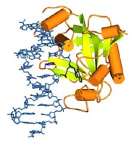 Halobacteria can repair badly damaged DNA. "We have completely fragmented their DNA. ...And they can reassemble their entire chromosome and put it back into working order within several hours," says Adrienne Kish, a member of the research group studying Halobacteria at the University of Maryland. These Archaea can also survive extreme dryness, a hard vacuum, and of course, high salt concentrations. We are not the only ones to notice that Halobacteria could use these capabilities to survive in space. [Thanks, Chandra Wickramasinghe and Marsbugs.]
Halobacteria can repair badly damaged DNA. "We have completely fragmented their DNA. ...And they can reassemble their entire chromosome and put it back into working order within several hours," says Adrienne Kish, a member of the research group studying Halobacteria at the University of Maryland. These Archaea can also survive extreme dryness, a hard vacuum, and of course, high salt concentrations. We are not the only ones to notice that Halobacteria could use these capabilities to survive in space. [Thanks, Chandra Wickramasinghe and Marsbugs.]
 Secrets of a Salty Survivor, Science@NASA, 10 Sep 2004. Secrets of a Salty Survivor, Science@NASA, 10 Sep 2004.
 Bacteria... is a related CA webpage. Bacteria... is a related CA webpage.
 Viruses... is a related CA webpage about gene transfer, in which DNA repair mechanisms may be essentlal participants. [Next-What'sNEW about HGT-Prev] Viruses... is a related CA webpage about gene transfer, in which DNA repair mechanisms may be essentlal participants. [Next-What'sNEW about HGT-Prev]
9 Sep 2004
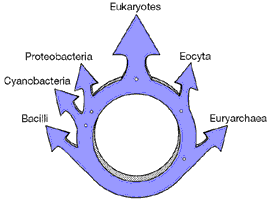 The ring of life! Two molecular biologists in California have compared a dozen whole genomes from yeasts and prokaryotes to conclude, "The eukaryotic genome resulted from a fusion of two diverse prokaryotic genomes, and therefore ...the tree of life is actually a ring of life."
The ring of life! Two molecular biologists in California have compared a dozen whole genomes from yeasts and prokaryotes to conclude, "The eukaryotic genome resulted from a fusion of two diverse prokaryotic genomes, and therefore ...the tree of life is actually a ring of life."
Using a new algorithm called "conditioned reconstruction," Maria Rivera and James Lake affirm the observation that "the informational genes of eukaryotes are primarily derived from Archaea and the operational genes are primarily derived from Bacteria." In passing they comment, "A substantial and continuous influx of mitochondrial DNA to the eukaryotic nucleus has been documented." Moreover, "The extensive horizontal transfer observed among prokaryotes can obscure the identities of those prokaryotes that may have contributed genes to eukaryotes." Tracking genes that retain their identities for billions of years, they mention no examples of genes that have acquired new functions by duplication and divergence. Instead, "The results derived in this paper argue against autogenous theories... in which eukaryotes are proposed to have evolved clonally from a single, possibly very ancient, prokaryote." Their conclusion strengthens our hunch that eukaryotes (not just prokaryotes) must acquire new genes, by whatever method, from beyond their own genomes.
 Maria C. Rivera and James A. Lake, "The ring of life provides evidence for a genome fusion origin of eukaryotes" [abstract], p 152-155 v 431, Nature, 9 Sep 2004. Maria C. Rivera and James A. Lake, "The ring of life provides evidence for a genome fusion origin of eukaryotes" [abstract], p 152-155 v 431, Nature, 9 Sep 2004.
 William Martin and T. Martin Embley, "Evolutionary biology: Early evolution comes full circle" [text], p 134-137 v 431, Nature, 9 Sep 2004. William Martin and T. Martin Embley, "Evolutionary biology: Early evolution comes full circle" [text], p 134-137 v 431, Nature, 9 Sep 2004.
 Nicholas Wade, "Team Hopeful in Its Effort to Recreate Primal Life" [text], The New York Times, 9 Sep 2004. Nicholas Wade, "Team Hopeful in Its Effort to Recreate Primal Life" [text], The New York Times, 9 Sep 2004.
 Complex Cells Likely Arose From Combination Of Bacterial And Extreme-microbe Genomes, ScienceDaily, 9 Sep 2004. Complex Cells Likely Arose From Combination Of Bacterial And Extreme-microbe Genomes, ScienceDaily, 9 Sep 2004.
 Viruses... is a related CA webpage with lots about gene transfer. [Next-What'sNEW about HGT-Prev] Viruses... is a related CA webpage with lots about gene transfer. [Next-What'sNEW about HGT-Prev]
 The Tree of Life is a related CA webpage. The Tree of Life is a related CA webpage.
 Testing Darwinism... is a related CA webpage. Testing Darwinism... is a related CA webpage.
1 Sep 2004
 Gene transfer among eukaryotes — Two independent studies show that there have been horizontal gene transfers between parasites and their vertebrate or plant hosts. "The huge significance of horizontal gene transfer for the evolution of prokaryotes has been known for a long time, as has the large contribution that intracellular endosymbiont ancestors of mitochondria and chloroplasts have made to eukaryotic genomes.... Studies such as these show that ongoing horizontal gene transfer from a range of parasites and endosymbionts might be more important for eukaryotic evolution than we previously realized — just how important remains to be seen."
Gene transfer among eukaryotes — Two independent studies show that there have been horizontal gene transfers between parasites and their vertebrate or plant hosts. "The huge significance of horizontal gene transfer for the evolution of prokaryotes has been known for a long time, as has the large contribution that intracellular endosymbiont ancestors of mitochondria and chloroplasts have made to eukaryotic genomes.... Studies such as these show that ongoing horizontal gene transfer from a range of parasites and endosymbionts might be more important for eukaryotic evolution than we previously realized — just how important remains to be seen."
 Nick Campbell, "Genome Evolution: Give and take" [article], p 638-639 v 5, Nature Reviews Genetics, Sep 2004. Nick Campbell, "Genome Evolution: Give and take" [article], p 638-639 v 5, Nature Reviews Genetics, Sep 2004.
 Charles C. Davis and Kenneth J. Wurdack, "Host-to-Parasite Gene Transfer in Flowering Plants: Phylogenetic Evidence from Malpighiales" [abstract], p 66-678 v 304, Science, 30 Jul 2004. Charles C. Davis and Kenneth J. Wurdack, "Host-to-Parasite Gene Transfer in Flowering Plants: Phylogenetic Evidence from Malpighiales" [abstract], p 66-678 v 304, Science, 30 Jul 2004.
 N. Nitz et al., "Heritable integration of kDNA minicircle sequences from Trypanosoma cruzi into the avian genome: insights into human Chagas disease" [RETRACTED!], p 175-186 v 118, Cell, 23 Jul 2004. N. Nitz et al., "Heritable integration of kDNA minicircle sequences from Trypanosoma cruzi into the avian genome: insights into human Chagas disease" [RETRACTED!], p 175-186 v 118, Cell, 23 Jul 2004.
 Constance Holden, "Withdrawn Parasite Paper Stirs Criticism of Cell" [link], p 34 v 310, Science, 7 Oct 2005. Constance Holden, "Withdrawn Parasite Paper Stirs Criticism of Cell" [link], p 34 v 310, Science, 7 Oct 2005.
 Viruses... is a related CA webpage with lots about gene transfer. [Next-What'sNEW about HGT-Prev] Viruses... is a related CA webpage with lots about gene transfer. [Next-What'sNEW about HGT-Prev]
|  photo width = c. 3 km photo width = c. 3 km |
31 Aug 2004 Changing spots on Mars that grow in spring on the dunes near Mars' North Pole are the subject of the "Astronomy Picture of the Day". In spite of the way they look, NASA does not believe they are biological.
 The Dotted Dunes of Mars, Astronomy Picture of the Day, 31 Aug 2004. The Dotted Dunes of Mars, Astronomy Picture of the Day, 31 Aug 2004.
 Dark spots which spread every Martian spring... is CA's first notice of the phenomenon, 7 Sep 2001. Dark spots which spread every Martian spring... is CA's first notice of the phenomenon, 7 Sep 2001.
 More about the changing dark spots on Mars gives another example of the phenomenon, 31 Jan 2002. More about the changing dark spots on Mars gives another example of the phenomenon, 31 Jan 2002.
 More changing spots on Mars shows another example of the phenomenon, 5 Nov 2003. More changing spots on Mars shows another example of the phenomenon, 5 Nov 2003.
 Life on Mars! is a related CA webpage. Life on Mars! is a related CA webpage.
| 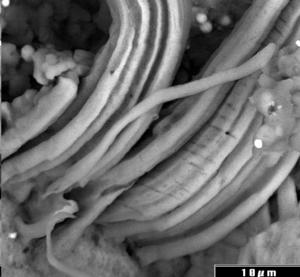 Microfossils in Orgueil; photo by Richard B. Hoover, NASA/NSSTC, 21-23 July 2004; sample courtesy of Paul Sipiera, the Dupont Meteorite Collection of the Planetary Studies Foundation. Microfossils in Orgueil; photo by Richard B. Hoover, NASA/NSSTC, 21-23 July 2004; sample courtesy of Paul Sipiera, the Dupont Meteorite Collection of the Planetary Studies Foundation. |
2 Aug 2004 Microfossils in a meteorite — at The International Symposium on Optical Science and Technology in Denver, Colorado, Richard B. Hoover of NASA/NSSTC in Huntsville, Alabama announced the possible detection of a fossilized cyanobacterial mat in the interior of the Orgueil carbonaceous meteorite.
Microfossils in meteorites have been reported before now (see related webpages linked below), but critics say that they may have been left by earthly contaminants. Yet the newly seen microfossils can hardly be contaminants because they are not isolated single cells, but whole ecologies whose earthly examples grow only under conditions that the meteorite fragment never experienced after landing here.
Conference attendees agreed that the new evidence, soon to be published in the Conference Proceedings, is momentous. Meanwhile, Hoover's group is gathering additional images and data for submission to a peer-reviewed scientific journal. For Hoover's discussion, a larger photo, and corroborating photos from Russia, see our new webpage linked (first) below.
 Evidence for Indigenous Microfossils in a Carbonaceous Meteorite is the new CA webpage with the full report and several images. Evidence for Indigenous Microfossils in a Carbonaceous Meteorite is the new CA webpage with the full report and several images.
 Comets... incudes a discussion of likely fossilized bacteria reported in the Orgueil and Ivuna meteorites in 1961. Comets... incudes a discussion of likely fossilized bacteria reported in the Orgueil and Ivuna meteorites in 1961.
 Fossilized Magnetotactic Bacterium in the Orgueil Meteorite discusses a microfossil announced in 1966. Fossilized Magnetotactic Bacterium in the Orgueil Meteorite discusses a microfossil announced in 1966.
 Fossilized Life Forms... is a CA webpage about some of Hoover's earlier related work. Fossilized Life Forms... is a CA webpage about some of Hoover's earlier related work.
 Fossilized Bacteria in Murchison and Efremovka has links about the contamination argument. Fossilized Bacteria in Murchison and Efremovka has links about the contamination argument.
 Richard B. Hoover, Gregory Jerman, Alexei Y. Rozanov and Paul P. Sipiera, "Indigenous microfossils in carbonaceous meteorites" [abstract], p 1-17, Proceedings of SPIE Volume 5555: Instruments, Methods, and Missions for Astrobiology VIII, [contents], Richard B. Hoover, Gilbert V. Levin and Alexei Y. Rozanov; eds., ISBN 0-8194-5493-1, Nov 2004. Richard B. Hoover, Gregory Jerman, Alexei Y. Rozanov and Paul P. Sipiera, "Indigenous microfossils in carbonaceous meteorites" [abstract], p 1-17, Proceedings of SPIE Volume 5555: Instruments, Methods, and Missions for Astrobiology VIII, [contents], Richard B. Hoover, Gilbert V. Levin and Alexei Y. Rozanov; eds., ISBN 0-8194-5493-1, Nov 2004.
 Orgueil meteorite, "A large carbonaceous chondrite that disintegrated and fell in fragments near the French town of Orgueil on May 14, 1864," from The Encyclopedia of Astrobiology, Astronomy, and Spaceflight, by David Darling. Orgueil meteorite, "A large carbonaceous chondrite that disintegrated and fell in fragments near the French town of Orgueil on May 14, 1864," from The Encyclopedia of Astrobiology, Astronomy, and Spaceflight, by David Darling.

27 July 2004
More about photosynthesis by gene transfer. In 2002, geneticists Raymond, Zhaxybayeva et al. used whole genome comparisons to conclude that photosynthesis in five groups of prokaryotes was acquired by gene transfer. In 2003, biologists at the University of Warwick found photosynthesis genes in a virus, S-PM2. Now, a team of biologists from Boston and San Diego "report the presence of genes central to oxygenic photosynthesis in the genomes of three phages from two [other] viral families...." The abstract of their writeup mildly concludes, "These gene transfers are likely to play a role in the fitness landscape of hosts and phages in the surface oceans." We note that evidence supporting gene transfer as the source for new genetic programs continues to accumulate. Meanwhile, evidence supporting a darwinian mechanism as the source for new genetic programs is lacking.
 Debbie Lindell et al., "Transfer of photosynthesis genes to and from Prochlorococcus viruses" [abstract], p 11013-11018 v 101, Proc. Natl. Acad. Sci. USA, 27 July 2004. Debbie Lindell et al., "Transfer of photosynthesis genes to and from Prochlorococcus viruses" [abstract], p 11013-11018 v 101, Proc. Natl. Acad. Sci. USA, 27 July 2004.
 Photosynthesis evolved by gene transfer: What'sNEW, 24 November 2002. Photosynthesis evolved by gene transfer: What'sNEW, 24 November 2002.
 Photosynthesis genes in a virus: What'sNEW, 14 August 2003. Photosynthesis genes in a virus: What'sNEW, 14 August 2003.
 Viruses... is the principal CA webpage about horizontal gene transfer. [Next-What'sNEW about HGT-Prev] Viruses... is the principal CA webpage about horizontal gene transfer. [Next-What'sNEW about HGT-Prev]
 25 July 2004
100 years old, Ernst Mayr reviews the development evolutionary thought in Science. We only wish that his interest in diversity and speciation included an equally penetrating curiosity about the sources of genetic programs for new features. Perhaps another of his stature will come along to explore that issue. [Thanks, Stan Franklin.]
 Ernst Mayr, "80 Years of Watching the Evolutionary Scenery" [summary], p 46-47 v 305, Science, 2 July 2004. Ernst Mayr, "80 Years of Watching the Evolutionary Scenery" [summary], p 46-47 v 305, Science, 2 July 2004.
 Neo-Darwinism... is a related CA webpage. Neo-Darwinism... is a related CA webpage.
08 July 2004
| 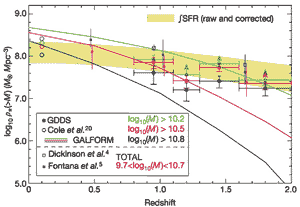 Proportion of old galaxies does not diminish with increasing redshift Proportion of old galaxies does not diminish with increasing redshift |
Big bang predictions are not upheld, according to two new reports. First, an English-speaking team surveyed 150 galaxies in four separate 30 arcmin fields at redshifts up to z = 2. They expected that the proportion of massive galaxies would decline with increasing redshift, because the massive ones would form more slowly after the big bang. They conclude, "There is a clear decline with redshift in stellar mass locked up in the most massive galaxies. This trend is in accord with ideas of gradual assembly. However, it declines only slowly towards high redshift and, surprisingly, the massive galaxies do not decline more rapidly than the whole population." Apparently, 3-6 billion years after the big bang, the proportion of massive galaxies was no different from today. They admit, "The evolutionary history of massive galaxies, as revealed by their visible stars and gas, is not accurately predicted."
Another survey by nine Italian and two German astronomers looked at massive spheroidal galaxies. These are are characterized by old stellar populations and are thought to appear "rather late in the history of the Universe as the culmination of a hierarchical merging process, in which larger galaxies are assembled through mergers of smaller precursor galaxies." Using the Very Large Telescope of the European Southern Observatory, the Italians obtained deep optical spectroscopy for 546 objects at redshifts of z > 1.5. Among them, four massive spheroidal galaxies were positively identified and three more candidates were observed. The standard big bang theory predicts that these galaxies would be entirely absent at the early stage indicated by the observed redshifts.
Most darwinists know little about the big bang, but they rely on it to mandate that life must originate. In cosmic ancestry life never originates and must come from the infinite past. Therefore we think it is important to understand the evidence for the big bang. In our opinion, the evidence does not give the big bang as much clout as darwinists (and creationists!) assume. [Thanks, Newshub.]
 Karl Glazebrook et al., "A high abundance of massive galaxies 3–6 billion years after the Big Bang" [abstract], p 181-184 v 430, Nature, 8 July 2004. Karl Glazebrook et al., "A high abundance of massive galaxies 3–6 billion years after the Big Bang" [abstract], p 181-184 v 430, Nature, 8 July 2004.
 A. Cimatti et al., "Old galaxies in the young Universe" [abstract], p 184-187 v 430, Nature, 8 July 2004. A. Cimatti et al., "Old galaxies in the young Universe" [abstract], p 184-187 v 430, Nature, 8 July 2004.
 Gregory D. Wirth, "Old before their time" [text], p 149-150 v 430, Nature, 8 July 2004. Gregory D. Wirth, "Old before their time" [text], p 149-150 v 430, Nature, 8 July 2004.
 Glimpse at Early Universe Reveals Surprisingly Mature Galaxies, Johns Hopkins University News Releases, 1 Jul 2004. Glimpse at Early Universe Reveals Surprisingly Mature Galaxies, Johns Hopkins University News Releases, 1 Jul 2004.
 The End and the Big Bang is a related CA webpage. The End and the Big Bang is a related CA webpage.
 Douglas Early replies, 28 Jul 20004. Douglas Early replies, 28 Jul 20004.
|
|

 Water vapor and methane concentrations are correlated in Mars' lower atmosphere. That they are concentrated in three regions at all implies that their release in those places is ongoing. And the correlation strengthens the possibility that the methane is biologically produced. The report comes from ESA's analysis of data from the Planetary Fourier Spectrometer aboard Mars Express. It was presented by Dr. Vittorio Formisano at the International Mars Conferrence in Ischia Italy, 19-23 September 2004. [Thanks, Larry Klaes, Jerry Chancellor, Justin Willingham and Marsbugs.]
Water vapor and methane concentrations are correlated in Mars' lower atmosphere. That they are concentrated in three regions at all implies that their release in those places is ongoing. And the correlation strengthens the possibility that the methane is biologically produced. The report comes from ESA's analysis of data from the Planetary Fourier Spectrometer aboard Mars Express. It was presented by Dr. Vittorio Formisano at the International Mars Conferrence in Ischia Italy, 19-23 September 2004. [Thanks, Larry Klaes, Jerry Chancellor, Justin Willingham and Marsbugs.] Halobacteria can repair badly damaged DNA. "We have completely fragmented their DNA. ...And they can reassemble their entire chromosome and put it back into working order within several hours," says Adrienne Kish, a member of the research group studying Halobacteria at the University of Maryland. These Archaea can also survive extreme dryness, a hard vacuum, and of course, high salt concentrations. We are not the only ones to notice that Halobacteria could use these capabilities to survive in space. [Thanks, Chandra Wickramasinghe and Marsbugs.]
Halobacteria can repair badly damaged DNA. "We have completely fragmented their DNA. ...And they can reassemble their entire chromosome and put it back into working order within several hours," says Adrienne Kish, a member of the research group studying Halobacteria at the University of Maryland. These Archaea can also survive extreme dryness, a hard vacuum, and of course, high salt concentrations. We are not the only ones to notice that Halobacteria could use these capabilities to survive in space. [Thanks, Chandra Wickramasinghe and Marsbugs.] The ring of life! Two molecular biologists in California have compared a dozen whole genomes from yeasts and prokaryotes to conclude, "The eukaryotic genome resulted from a fusion of two diverse prokaryotic genomes, and therefore ...the tree of life is actually a ring of life."
The ring of life! Two molecular biologists in California have compared a dozen whole genomes from yeasts and prokaryotes to conclude, "The eukaryotic genome resulted from a fusion of two diverse prokaryotic genomes, and therefore ...the tree of life is actually a ring of life."
 Gene transfer among eukaryotes — Two independent studies show that there have been horizontal gene transfers between parasites and their vertebrate or plant hosts. "The huge significance of horizontal gene transfer for the evolution of prokaryotes has been known for a long time, as has the large contribution that intracellular endosymbiont ancestors of mitochondria and chloroplasts have made to eukaryotic genomes.... Studies such as these show that ongoing horizontal gene transfer from a range of parasites and endosymbionts might be more important for eukaryotic evolution than we previously realized — just how important remains to be seen."
Gene transfer among eukaryotes — Two independent studies show that there have been horizontal gene transfers between parasites and their vertebrate or plant hosts. "The huge significance of horizontal gene transfer for the evolution of prokaryotes has been known for a long time, as has the large contribution that intracellular endosymbiont ancestors of mitochondria and chloroplasts have made to eukaryotic genomes.... Studies such as these show that ongoing horizontal gene transfer from a range of parasites and endosymbionts might be more important for eukaryotic evolution than we previously realized — just how important remains to be seen." Pack-MULE transposable elements mediate gene evolution in plants. Geneticists from the University of Georgia and Washington University think so after examining Mutator–Like transposable Elements (MULEs) that are found in many eukaryotic genomes. In well-studied plants they are known to carry fragments of cellular genes. The researchers named these ones "Pack-MULEs".
Pack-MULE transposable elements mediate gene evolution in plants. Geneticists from the University of Georgia and Washington University think so after examining Mutator–Like transposable Elements (MULEs) that are found in many eukaryotic genomes. In well-studied plants they are known to carry fragments of cellular genes. The researchers named these ones "Pack-MULEs". A diatom genome has been sequenced. A team of 45 genetictsts identified almost 11,500 genes in 24 nuclear chromosomes, a plastid and the mitochondria. "The assemblage of genes identified... reflects large-scale transfers of genes between genomes during establishment of the endosymbiosis," they write. Although many unexpected or unfamiliar genes are seeen, the only source they suggest for any genes not vertically inherited with retained function is transfer, usually following symbiosis.
A diatom genome has been sequenced. A team of 45 genetictsts identified almost 11,500 genes in 24 nuclear chromosomes, a plastid and the mitochondria. "The assemblage of genes identified... reflects large-scale transfers of genes between genomes during establishment of the endosymbiosis," they write. Although many unexpected or unfamiliar genes are seeen, the only source they suggest for any genes not vertically inherited with retained function is transfer, usually following symbiosis. Cassini flew by Titan, 1200 km above its surface at 8:30 AM Pacific time, 26 October. The atmosphere was less cloudy and more diverse than NASA expected, and the light and dark splotches on the surface remain unexplained. This was the first of planned series of 45 close flybys of Saturn's largest moon. Eventually Cassini will release a probe named Huygens to descend to Titan's surface and investigate, among other things, the source for methane there.
Cassini flew by Titan, 1200 km above its surface at 8:30 AM Pacific time, 26 October. The atmosphere was less cloudy and more diverse than NASA expected, and the light and dark splotches on the surface remain unexplained. This was the first of planned series of 45 close flybys of Saturn's largest moon. Eventually Cassini will release a probe named Huygens to descend to Titan's surface and investigate, among other things, the source for methane there.

 Retroelements such as retrotransposons were once thought to be examples of "selfish genes," but this gene is clearly beneficial to the viral species carrying it. Interestingly, genes with similar diversity-generating casettes are already seen in various bacteria.
Retroelements such as retrotransposons were once thought to be examples of "selfish genes," but this gene is clearly beneficial to the viral species carrying it. Interestingly, genes with similar diversity-generating casettes are already seen in various bacteria.






